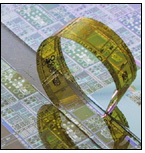Feb 01, 2005More than 98 percent of a silicon wafer is just a physical carrier that doesn’t add to a microchip’s function. Researchers at Philips Semiconductors, a maker of RFID chips, have figured out how to get rid of the silicon while keeping the circuitry. The result: the world’s thinnest RFID transponder.
The researchers glue a microchip face down onto glass, foil or some other surface, grind away the silicon and add a layer of nitride that acts as a semiconductor. Philips and Mühlbauer of Germany have created a prototype tag less than 20 microns
thick, compared with 40 microns or more for traditional wafer-thinning techniques. The prototype operates at 680 MHz and has a built-in loop antenna.
Integrated into paper, the tags could be used to prevent the counterfeiting of money and secure the authenticity of passports, securities and other documents. It’s still a few years away from commercialization, but it could give new meaning to the term “reading the paper.”

